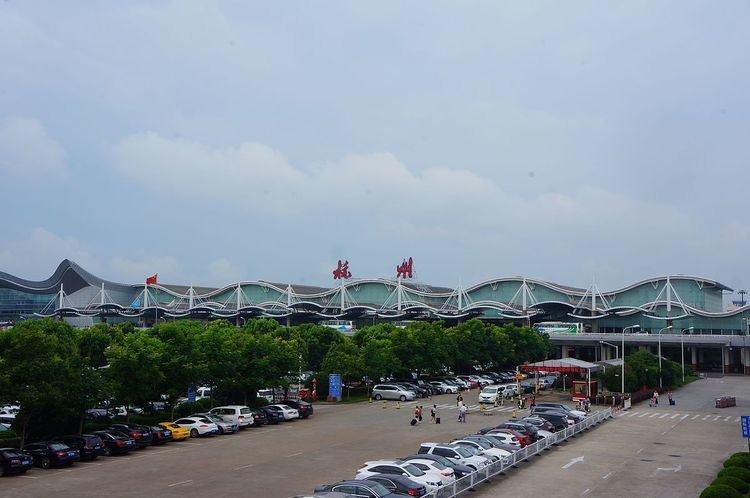Airport type Public Code HGH Yearly aircraft movements 251,048 | Location Xiaoshan District Elevation 7 m Phone +86 571 8666 2999 Passenger count 31,594,959 | |
 | ||
Hub for Loong AirXiamen Airlines Focus city for Air ChinaChina Southern AirlinesChina Eastern AirlinesHainan Airlines Address Xiaoshan, Hangzhou, Zhejiang, China | ||
China eastern airline a330 300 landing hgh hangzhou xiaoshan international airport
Hangzhou Xiaoshan International Airport (IATA: HGH, ICAO: ZSHC) is the principal airport serving Hangzhou, a major city in the Yangtze River Delta region and the capital of Zhejiang Province, China. The airport is located on the southern shore of Qiantang River in Xiaoshan District and is 27 km east of downtown Hangzhou. Architecture firm Aedas designed Hangzhou Xiaoshan International Airport.
Contents
- China eastern airline a330 300 landing hgh hangzhou xiaoshan international airport
- 161201 victoria hangzhou xiaoshan international airport
- History
- Facilities
- Airport bus
- Taxi
- Highway
- References
The airport has service to destinations throughout China. International destinations are mainly in east and southeast Asia, and points of Africa, Europe and south Asia. The airport also serves as a focus city for Air China, China Eastern Airlines, China Southern Airlines, Hainan Airlines and Xiamen Airlines.
In 2016, Hangzhou airport handled 31,594,959 passengers, which ranked 10th in terms of passenger traffic in China. In addition, the airport was the country's 7th busiest airport in terms of cargo traffic and the 10th busiest airport by traffic movements.
161201 victoria hangzhou xiaoshan international airport
History
The airport was planned to be constructed in three phases. The first phase of construction started in July 1997, and was completed and opened for traffic on 30 December 2000. It replaced the old Hangzhou Jianqiao Airport, which was a dual-use civil and military airfield. In March 2004, the airport officially became an international airport after immigration and customs facilities were built and put into service. A second runway of 3,600 meters is also under construction. Terminal extensions are also under construction as of 2012.
The airport was a hub of CNAC Zhejiang. After the airlines' merger with Air China, the latter inherited the Hangzhou hub.
On the evening of 9 July 2010, the airport was shut down for an hour when an unidentified flying object was detected. Air traffic control could not locate it on radar and prudently waved off landing flights. Eighteen flights were affected. Though normal operations resumed four hours later, the incident captured the attention of the Chinese media and sparked a firestorm of speculation on the UFO's identity.
Facilities
Phase One of the airport occupies 7,260 acres (29.4 km2) of land. It has a capacity of eight million passengers and 110,000 tons of cargo a year, and can handle aircraft as large as the Boeing 747-400. It has one runway which is 3,600 metres (11,800 ft) long and 45 metres (148 ft) wide. The passenger terminal can handle 3,600 passengers an hour and is 100,000 square metres in size (including an underground parking of 22,000 square metres). The departure level has 36 ticket counters, including 12 in the international side of the terminal. There are 2,900 seats in the departure lounge. The immigration and customs area occupies 9,500 sq. metre of terminal space.
The apron occupies 340,000 square metres of land, and there are 12 jetways and 18 departure gates.
Maintenance facilities are certified to perform B-Check on all types of aircraft and C-Check on Boeing 737 and Boeing 757 aircraft.
Phase Two of the airport expansion project began construction on 8 November 2007. It included an International Terminal, a second Domestic Terminal, and a new runway. The International Terminal was completed on 3 June 2010. The terminal has 8 air bridge gates, with one gate capable of handling the Airbus A380. All international flights, including flights to Hong Kong, Macau, and Taiwan depart from this terminal. The original terminal handles exclusively domestic flights. All other constructions were completed and operations began on 30 December 2012.
The new runway is 3,400 metres (11,200 ft) long and 60 metres (200 ft) wide, which is capable of handling the Airbus A380. The new domestic terminal (T3) has 90 Check-in desks and 21 Self Check-in counters. It also adds 26 security lanes and 31 aerobridge gates. All public spaces of the terminal has free WIFI services. With the addition of the new passenger terminal, the airport now has a total terminal floor area of 37 million square metres and will enable the airport to handle 8,520 passengers at peak hour and 32.5 million passengers annually.
Loong Airlines has its headquarters in the Loong Air Office Building (长龙航空办公大楼 Chánglóng Hángkōng Bàngōngdàlóu) on the airport property.
Airport bus
There are airport bus services linking the airport to points throughout Zhejiang and cities in Jiangsu.
Bus services to/from downtown Hangzhou originate/terminate at the Ticketing Office on Tiyuchang Road with intermediate stops in between.
Taxi
Taxi between the airport and downtown Hangzhou costs between ¥100 to ¥160.
Highway
The Airport is accessed by Airport Road, which connects to the Airport Expressway and is linked to downtown Hangzhou by the Xixing Bridge. The Airport Expressway also has an exit at North Shixin Road, which is linked to downtown Xiaoshan. The Shanghai-Hangzhou-Ningbo Expressway has an exit at the airport.
